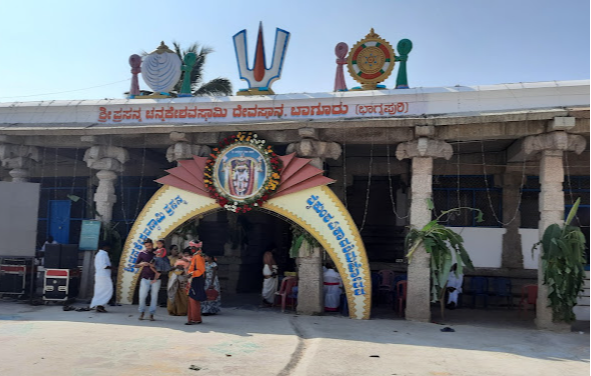Sri Chennakesava Swamy Temple in Bagur, Karnataka, dates back to the 12th century and was built during the reign of the Hoysala Empire, known for its contributions to South Indian temple architecture. The Hoysalas, under rulers like Vishnuvardhana, were great patrons of art and architecture, and they constructed numerous temples dedicated to various Hindu deities. This temple exemplifies the Hoysala architectural style, characterised by intricate carvings, detailed sculptures, and star-shaped platforms. The temple not only served as a place of worship but also as a centre for cultural and social gatherings. Over the centuries, it has remained an important religious and historical site, reflecting the rich heritage of the region.
Back to Results


Sri Chennakesawa Swamy Temple
Sri Chennakesava Swamy Temple in Bagur, Karnataka, is a 12th-century Hindu temple dedicated to Lord Vishnu. It is famous for its intricate Hoysala architecture, featuring detailed carvings and sculptures. The temple is a significant cultural and religious site, known for its historical and architectural beauty.
Timings
It is open daily from 7.30 AM till 7.30 PM.
Entry Fee
Free of cost
Do's and Don'ts
- Respectful Attire: Dress modestly and conservatively, covering shoulders and knees. Avoid wearing revealing or inappropriate clothing.
- Observe Silence: Maintain a quiet and respectful demeanour inside the temple premises, especially during prayers and rituals.
- Remove Footwear: Remove footwear before entering the temple complex as a sign of reverence. Some temples may have designated areas for footwear storage.
- Wash Hands and Feet: Wash hands and feet before entering the main shrine area as a symbolic act of purification.
- Follow Rituals: Observe and participate in temple rituals and ceremonies respectfully. Follow the instructions of priests and temple authorities.
- Offerings: Make offerings of flowers, incense, and prasad (food offerings) to the deity as a sign of devotion. Offer donations to support temple maintenance and charitable activities.
- Prayer and Meditation: Spend time in prayer, meditation, or quiet reflection to connect with the divine and experience spiritual upliftment.
- Photography Restrictions: Respect any photography restrictions inside the temple premises. Avoid taking photos of the main deity or during sacred rituals without permission.
- Littering: Do not litter or leave behind trash in the temple complex. Dispose of waste responsibly in designated bins.
- Disrespectful Behaviour: Refrain from engaging in loud or disruptive behaviour, smoking, or consuming alcohol within the temple premises.
- Pointing Feet: Avoid pointing feet towards the deity, sacred objects, or other worshippers, as it is considered disrespectful in Indian culture.
- Touching Sacred Objects: Refrain from touching or disturbing sacred objects, sculptures, or offerings without permission.
- Unauthorised Entry: Do not enter restricted areas or areas meant only for priests and authorised personnel.
- Interrupting Rituals: Avoid interrupting ongoing rituals or ceremonies. Wait for the appropriate time to offer prayers or make offerings.
Dress Code
For Men:
- Traditional Attire: Wear traditional Indian clothing such as dhoti, kurta, or pyjama with a shawl or stole. Alternatively, formal trousers with a shirt are also acceptable.
- Covered Shoulders and Legs: Ensure that shoulders and knees are covered. Avoid wearing sleeveless shirts, tank tops, shorts, or tight-fitting clothing.
For Women:
- Traditional Attire: Opt for traditional Indian attire such as saree, salwar kameez, or lehenga. If wearing western clothing, choose a modest outfit such as a long skirt or dress with a shawl or scarf.
- Covered Shoulders and Legs: Make sure shoulders and knees are covered. Avoid wearing sleeveless tops, low-cut blouses, short skirts, or tight-fitting clothing.
- Dupatta or Shawl: Carry a dupatta or shawl to cover the head and shoulders, especially while entering the inner sanctum or during prayers.
How to reach
- By Train: Nearest Railway Station: The nearest major railway station to Bagur is in Hospet, located approximately 35 kilometres away. From Hospet, you can hire a taxi or take a bus to reach Bagur.Li
- By Air: Nearest Airport: The nearest airport to Bagur is Hubli Airport (HBX), located about 165 kilometres away. From the airport, you can hire a taxi or take a bus to reach Bagur
Nearby Cities and Rivers
Rivers:
- Tungabhadra River: The Tungabhadra River, a tributary of the Krishna River, flows in close proximity to Bagur. It is a lifeline for agriculture and supports the livelihoods of people in the region.
- Hagari River: The Hagari River, another tributary of the Krishna River, also passes through the vicinity of Bagur. It contributes to the irrigation needs of the surrounding agricultural lands.
Cities/Towns:
- Hospet: Located approximately 35 kilometres southwest of Bagur, Hospet is a major city known for its proximity to the UNESCO World Heritage Site of Hampi. It serves as a hub for tourists visiting the Hampi ruins and other nearby attractions.
- Bellary: Bellary, situated around 70 kilometres northwest of Bagur, is a historic city known for its rich cultural heritage and mineral resources. It has several temples, forts, and natural attractions worth exploring.